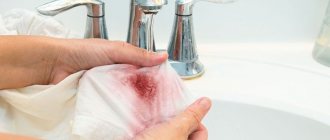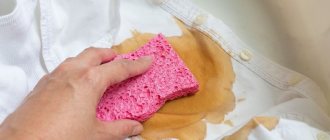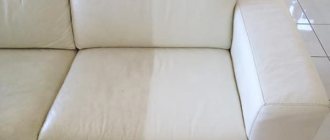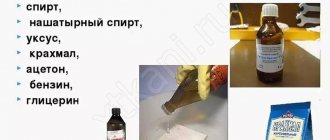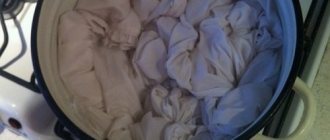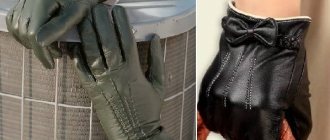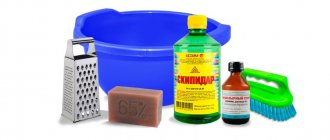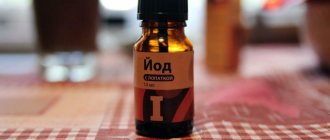The basic rule for removing juice stains from vegetables and fruits is emergency washing. Use green tomato, ammonia, hydrogen peroxide, vinegar, glycerin. Apply the selected product to the stain, let it absorb, and then wash with laundry soap.
Picking and preparing tomatoes is a painstaking process, which often leaves persistent, difficult-to-remove stains on clothing. To get rid of them, it is enough to approach the procedure competently.
Features of removing stains from white things
There are quite accessible, home-made methods and means for removing tomato blots. Here are some recipes.
Hydrogen peroxide
According to the second version of the recipe, you need to pour a teaspoon of peroxide into 100 ml (half a glass) of water and wipe the part of the clothing damaged by tomatoes quite vigorously with this solution. Then wash the product.
The recipe is suitable for removing stains on white, light-colored fabric. Colored clothing may be damaged when stained with hydrogen peroxide, changing color. Therefore, if the fabric is colored, you need to try how it will interact with peroxide on an inconspicuous area of clothing.
Ammonia and salt
A teaspoon of ammonia is mixed with a teaspoon of salt, mixed until smooth. The resulting slurry is applied to the area stained with ketchup or sauce and left on it for 30-40 minutes. Then the slurry is removed with a brush or a toothbrush (for example, a toothbrush).
Second version of the same recipe. Apply salt to the area damaged by the tomato, moistened with water, and leave for the same 30-40 minutes. After this, the salt is removed, and the soiled part of the clothing is wiped with ammonia.
It is better to wash the product after this procedure for removing stains from tomatoes or tomato paste in soapy water rather than powder.
Regular vinegar
Typically, table vinegar is diluted half-and-half with water and a blot of ketchup, tomato paste or tomatoes placed on clothes is wiped until it brightens.
If you use vinegar essence, in which the percentage of acetic acid is much higher than in table vinegar, it is diluted to the concentration of ordinary table vinegar according to the recipe written on the label of the essence, and then dilute this solution in the required amount with water, like ordinary vinegar. The second option is to calculate how much essence and water you need mathematically, but this is much more difficult.
It is better to use vinegar to remove stains on natural fabrics (cotton or others).
Acids
In addition to vinegar, you can use other acids, natural or synthetic:
- lemon juice;
- citric acid (solution);
- oxalic acid (solid) and others.
The stained areas are wiped with liquid products, and sprinkled with solid products.
Mineralka
How can you remove a tomato stain on woolen fabric? Mineral water will help with this, preferably carbonated water. The soiled area is soaked with it.
Milk
Warmed milk is applied to the stained area. It’s better, on the contrary, to dip the soiled part of the clothing in heated milk for 30-40 minutes. Then wash it.
Glycerol
There are several options for using glycerin to clean tomato stains from clothes. The first way is to simply saturate the stained area with glycerin and wait 15-20 minutes. If it doesn’t help or doesn’t help, the procedure is repeated.
The second method is to use glycerin with ammonia. They are mixed in a ratio of 4 to 1, respectively. The mixture is applied to the area damaged by the tomato and left for 2-3-4 hours. Then the mixture is removed, and the item is washed.
Another option is after treating the stained area with glycerin, wipe it with ammonia.
Tomato sauce or ketchup can leave stubborn stains on clothing that are difficult to remove, especially on white clothing. Immediately after they appear, the sauce should be washed off with water, and there is no need to make rubbing movements to prevent the stain from drying out and being deeply absorbed into the fibers of the fabric. Then the tomato traces are treated with ammonia chloride, which is poured onto the dirty area, and washed off after 5 minutes. Ammonia chloride can be replaced with hydrogen peroxide.
Tomato stains on white clothes can be washed using potassium permanganate. To do this, immerse contaminated clothing in a solution of potassium permanganate for 15-20 minutes, after which the product should be washed and thoroughly rinsed.
As is obvious from the article, tomato stains are not that difficult to remove. There are many simple ways to help get rid of them.
It is important to choose the right method that is suitable for a specific item in order to achieve an ideal result.
Another interesting article on a similar topic: How to remove grease stains.
Carpets and rugs
Household chemicals can remove tomato stains: Vanish for carpets, Cinderella, Nordland. The following home methods have worked well:
- water + ammonia - mix the ingredients equally, go over the tomato stain, wash off and dry;
- salt + vodka – mix in equal parts, treat the carpet, leave the mixture of alcohol and salt for half an hour, rinse. If necessary, go through with soap foam, which will help get rid of stains;
- mineral water – suitable only for fresh stains. It prevents pigments from penetrating deep into the fibers and removes juice from the carpet. After processing, the pile must be dried thoroughly.
How to Remove Stains from White Clothes
Hydrogen peroxide
Hydrogen peroxide will save snow-white cotton fabric. It must be poured onto the contamination, using one-half of the bottle. Half an hour is allowed for contact with clothing, then the item is washed in a washing machine. A nice bonus: a grayed item will sparkle with whiteness and will delight you with a fresh look.
Lemon
You don’t have to be afraid to wash white clothes with strong acidic agents. For example, you can mix half and half lemon and vinegar. Cotton wool is soaked in the solution and the tomato stain is wiped off. The cotton wool is changed, and finally, a clean lemon-vinegar disc is left on the stain for 15 minutes. The stain will definitely lighten, if not disappear completely. The remains are washed in the machine with powder and rinsed as usual. If there are no conditions for washing (for example, at a party), you can simply apply a slice of lemon to the tomato stain. The acid will eat away the dirt and the item will not deteriorate.
Lemon acid
Rinse the item in cold water, then add a packet of citric acid. After an hour, the item is removed and the condition of the stain is assessed. If it is still there, wash it off with laundry soap. Next, the item is washed in the usual way in a machine and rinsed.
Fabric dyeing
If none of the above methods helped (which is unlikely), you can try a radical method - repainting the item.
Using the tools listed above, you can easily put your clothes in order and make your life much easier, saving on buying new things.
General recommendations
Several conditions must be observed to remove tomato stains. These include:
- Timeliness - the older the stain, the more difficult it is to remove. Already ten days of stains affect the structure of the fabric, so there is a greater chance of removing a fresh stain without losing the quality of the item;
- You should never put items with such contaminants in the washing machine. Be sure to wash everything by hand using appropriate products;
- You need to wash off the stain from the edges to the center, collecting dirt, and not rubbing it even more over the entire surface;
- You need to be careful when using acids to remove stains from colored clothing. Most of them are still intended for light-colored things, more often white;
- When treating contaminants, it is better to place clothes on a hard surface, placing an old cloth under it. Stains will be removed, and the rag will absorb dissolved dirt.
How to remove old grease stains from clothes at home
This is difficult to do, unlike fresh contaminants. More aggressive methods will be required: gasoline, acetone, ammonia and others. When even these products do not help remove an old stain, you should resort to professional dry cleaning services.
Hot water and salt
You can remove stains using a hot saline solution. You need to pour 5 tbsp into a liter of boiling water. salt. For a bulk product, more water and salt are needed. Place the item in salt water, lightly rub the contaminated area, and leave for an hour. Then we wash the clothes thoroughly.
You can remove stains by soaking them in warm water, generously treating them with salt, rubbing a little and leaving. After half an hour, brush off the grains of salt and wash the item. Salt does not leave streaks and eliminates the need to wash an entire item. Used on its own or applied over various detergent compositions.
Toothpaste
Thanks to gel toothpaste, you can clean stains from colored clothes. If the dirt is deeply ingrained into the fabric, leave the paste on, and after 60-120 minutes wash the item.
Glycerol
Helps with grease stains formed on delicate materials (silk, cashmere). Regular pharmaceutical glycerin is used. Drop a little product onto the contaminated material and wash it off with a sponge after half an hour.
If a trace remains after washing, it is recommended to make the following mixture: mix glycerin with ordinary water and ammonia in equal parts. We soak the contaminated area in this composition, leave for a quarter of an hour, and wash.
Turpentine and ammonia
Many people don’t know how to remove old grease stains from their favorite things. One of the best folk mixtures (1:1) will help, thanks to which fat is easily removed. Apply the composition to the contaminated fabric and leave for about 60-90 minutes. Then the item should be washed by hand. Due to its delicate effect, ammonia with turpentine can be used on materials subject to shrinkage and shedding.
To clean synthetic items, use a mixture of ammonia (1 tsp) and 100 ml of warm water. Apply the composition to a sponge, which we use to wipe away the greasy dirt. Afterwards, this place must be carefully ironed through tracing paper or a napkin. Ammonia also cleans jeans well.
Wood chips and gasoline
Sawdust, which must be pre-treated with gasoline, will help get rid of greasy stains on the floor covering. We soak the stained fabric with the resulting slurry, let it sit for a third of an hour, and clean it with a sponge. If it is not washed off, repeat the procedure a couple of times.
Gasoline works well for greasy stains on clothes made of dark materials. They should wet the fabric well, let it sit for about 40 minutes, and wash it.
https://youtube.com/watch?v=HjBY7DcZqJU
Soda and detergent
You can clean greasy stains from any fabric using dishwashing liquid. Soda enhances this effect.
We wet the contaminated area, thoroughly soap it, and then sprinkle it with soda. Leave for 1.5 hours, then rinse the product.
Why is tomato juice dangerous?
Tomato fruits contain a special coloring substance of the carotenoid family - lycopene. Carotenoids are responsible for the bright (yellow, orange, red) color of many vegetables, fruits and flowers - carrots, tomatoes, pumpkins, peppers. Lycopene is insoluble in water.
For this reason, stains on fabric from any tomato derivatives, be it tomato paste, juice, ketchup or sauce, are quite difficult to remove. And it is tomato juice that is the most harmless of those listed, since, unlike sauce, it contains no fat.
In any case, do not despair, some practical tips will help you save your favorite thing.
Starch
In cases where it is not recommended to wash contaminated fabric to avoid losing any of its qualities, you can use potato starch. It is he who will effectively, correctly and delicately cope with traces of fat at home.
To do this, you need to apply a thin layer of starch to the grease stain and gently rub it, covering the entire contaminated surface. Within 15-20 minutes, the starch will work to intensively pull out fat particles from the material.
After this process, you need to take a damp cloth and carefully remove the starch and fat absorbed from the surface of the material.
Removing more stubborn grape marks
Old stains are much more difficult to remove, but still possible. How to most effectively remove stains from black grapes:
The easiest way is to use warm kefir or sour milk. Soak the product in a milk drink for about 7-8 hours. During this period of time, the acid will actively interact with the trace of the grapes. And after time, the owner will only have to thoroughly wash everything with powder and rinse. This method is ideal for delicate fabrics, since it completely eliminates aggressive components. You can also prepare a homemade paste from 1 spoon of ammonia and salt. The mixed ingredients are applied to a pre-moistened surface for half an hour. Afterwards, you just need to rinse the item. If none of the methods work, then you can use the last and most effective
Important! The aggressive substances used in this method can damage the fragile structure of delicate fabrics. It is necessary to treat the stain with 2 grams of citric acid crystals diluted in a tablespoon of ethyl alcohol
After which the area is treated with a solution of ammonia and water, diluted in a ratio of 1:3. Finally, the stain is treated with a cotton swab dipped in a solution of 1 tbsp. l. table vinegar and 20 ml of water. An old mark from a berry on a delicate and colored item can be removed with egg yolk mixed with a spoonful of glycerin. The mixture is applied with a toothbrush and, without waiting for the yolk to dry, is washed off with cold water. Afterwards, you can wash your clothes with your usual washing powder.
Household chemicals
Sometimes the trace left by a berry can become so ingrained into the structure of the fabric that only specialized household chemicals can cope with them. To return things to their original neat appearance, you need to study the list of effective remedies. However, today they already occupy leading positions among the 4 most effective stain removers.
On the reverse side, the instructions contain detailed information about the rules of use and recommendations given regarding the materials to be cleaned. You should study everything carefully, and before washing, try the product on an inconspicuous area of clothing to make sure that the fabric structure and color will not be damaged. How to remove grape stains:
- Vanish stain remover. One of the most famous remedies today that can remove a grape stain. It is suitable not only for clothes, but also for cleaning furniture upholstery. The pre-moistened contamination is covered with powder and Vanish is poured on top. Next, the clothes are placed in warm water to soak. If after 5-6 hours there are barely visible stains, they can be treated with lemon juice and only then put in the washing machine.
- Antipyatin soap. Beef bile, which is part of the soap, can fight even the most complex stains. The soiled area is soaped and left to act for half an hour. After the time has passed, the clothes are washed in a washing machine at a temperature of 60 degrees.
- Powdered oxygen bleach. This is another fairly common remedy that makes the life of every housewife much easier. The powder must be diluted in water to a paste and applied to the stain using a toothbrush. The proportions and interaction time are determined based on the instructions. Without rinsing off the product, you need to wash your clothes in a washing machine.
- Stain remover Dr. Beckmann. The manufacturer has worked hard and created a special stain remover aimed at eliminating stains from berries and fruits. The line of products is called “Fruits and Drinks”. The dirty mark must be moistened and sprinkled with stain remover. Then moisten the treated area again. The recommended active exposure time is 60 minutes. After time, the composition is thoroughly washed off, and clothes should be washed as usual.
How to remove perfume stains from clothes
The appearance of numerous perfume stains on clothes is a fairly common occurrence. Often, without thinking about the consequences, a girl, when using her favorite perfume, ends up on her favorite blouse. Subsequently, the material on which the perfume falls loses its presentation - unsightly, difficult to remove greasy stains appear. Most women eventually come to the conclusion that the only thing that can be done in this situation is to throw away their favorite thing.
In fact, it is really difficult to get rid of such stains, because any perfume contains not only alcohol, but also various oil components. It is for this reason that it is considered almost impossible to remove perfume stains from your clothes, no matter what material your favorite soiled blouse is made of.
Several ways to remove perfume stains from clothes
However, it is worth trying to fight the stain; for this, housewives have tried some recipes.
- Alcohol is considered the most effective way to remove perfume stains. But it can only show its effectiveness if the stain is completely fresh. To get rid of it, just wipe the contaminated area with a cotton swab soaked in alcohol (or vodka), and then wash the product in the washing machine using your usual detergents.
- The second most popular way to remove stains from perfume and cologne is to use ammonia and peroxide. This method is used to combat old stains that alcohol is no longer able to deal with. To obtain the required product, you need to mix the components in equal proportions, and then treat the entire contaminated surface. Then wash the product as usual.
- The simplest, but at the same time very effective way is to use ordinary laundry soap. You can remove stains in this way from any type of fabric; you just need to take a simple bar, lather it on the stained area and leave it in that state for literally ten minutes. At the end of the designated time, you can simply wash the product in your usual way.
- Another option on how to get rid of the hated dirt left by perfume is to use alcohol and cosmetic clay. The latter, and it is preferable to take white, since it copes best with various contaminants. In order to remove stains, you need to make a paste out of clay, mixing it with a small amount of alcohol. Apply the resulting mixture to the perfume stain and leave until completely dry. After this, you need to carefully shake off the clay layer from the product and wash it in the usual way.
- If your white clothes have been damaged by perfume, you will need to make a little more effort to remove such stains. First, you need to moisten the contaminated area with ordinary ammonia, then make a solution of hydrogen sulfate. To prepare it, you need to take about four grams of powder per full glass of water. After preparation, moisten the damaged area with the resulting solution. After three minutes, moisten the stain with a solution of oxalic acid. To prepare it, you need to take five grams of acid per glass of water. The final step is to wash the item thoroughly and leave it to dry naturally.
- Another option is to use glycerin, which is very effective at removing stains from woolen items. Glycerin must be heated and moistened with dirty material, after which the area must be thoroughly treated with a regular cotton swab, generously soaked in acetone.
If you see a perfume stain on your clothes, don’t despair. This problem can be easily solved by spending a little of your free time. If none of the above methods help, you can go to the store and buy a good modern stain remover or take the item to the dry cleaner.
Cushioned furniture
If the upholstery is damaged, then a suitable store-bought product can remove the tomato juice stain: Tuba, Unicum, KARCHER. If you don't have the product you need on hand, a mixture of lemon juice and baking soda will help. Immediately after the reaction is completed, the composition is cleaned with a soft brush and the upholstery is dried. It is not advisable to wet upholstered furniture with water. This will not help get rid of tomato juice, but will lead to deeper penetration of the pigment into the fibers.
Dear readers of the Tkan.Club website, if you still have questions on this topic, we will be happy to answer them. Leave your reviews, comments, share stories of how you removed lipstick marks! Your life experience may be useful to other readers.
How to remove a fresh grease stain
A fresh greasy stain (if no more than three hours have passed) is the easiest to remove. Sometimes simply treating the contaminated area with any detergent and then washing is enough. If after treatment the stain still remains, do not wash the item under any circumstances; the stain must be completely removed before you start washing.
Do not wash stained items in the washing machine without first treating the stained area. This can make the situation worse and it will be even more difficult to remove the stain.
As a pre-treatment for a fresh grease stain, you can use one of the following methods.
Dishwashing liquid
Dishwashing detergent contains special ingredients that absorb grease. Wet the contaminated area with water and apply a small amount of liquid to it. Wash, leave for 15 minutes, then rinse with water. If the stain has disappeared, you can wash the clothes in the washing machine with powder. If traces of fat still remain, repeat the procedure before washing.
To remove grease stains from clothes made from light-colored fabrics, use colored detergents with caution, as they can stain them.
Shampoo for oily hair
Less effective than dish soap, but suitable for delicate fabrics such as wool, velvet, silk and chiffon. Apply a small amount of shampoo to the stain, gently wash, leave for half an hour and wash in warm water without using powder.
Table salt
Using this product, you can remove not only grease stains from clothes, but also stains from wine, berries and sweat. But salt is only effective on fresh stains. Therefore, as soon as the stain is placed on the clothing, you need to sprinkle the area with salt and lightly rub it. When the salt has absorbed the fat, remove it and sprinkle with new salt again. Repeat the procedure until completely cleansed. Afterwards wash as usual.
Ammonia
To remove grease stains from synthetic clothing, use a mixture of a teaspoon of ammonia and half a glass of warm water. Apply to a light cloth and rub off the stain. Then iron this area well through a napkin.
Toothpaste
Regular toothpaste also works well on greasy stains on clothes. Apply it to the dirty area, leave it for a couple of hours and wash well. For clothes made of light fabrics you can use any paste; for colored ones it is better to use gel paste.
Chalk
You can safely remove a greasy stain from clothes made from natural fabrics (linen, cotton, etc.) using crushed chalk. Apply chalk powder to the desired area, leave for a couple of hours, then remove with a damp piece of cloth and wash the item as usual.
Talc, starch and baby powder
Clothes made of wool and silk require delicate care. To remove stains, use gentler products - talc or baby powder. Place the clothes on an ironing board or other flat surface, sprinkle the contaminated area with talcum powder and cover with a napkin. Use a warm iron and place something heavy on this place. Leave for several hours.
Bread crumb
Fat absorbed into the small fibers of velvet clothing can be easily removed with fresh white bread. Take a piece of warm crumb, blot the stain with it and wash the item in soapy water without using powder.
Tracing paper
This method can be used on clothes made of any material that can be ironed. Place pieces of tracing paper in place of the stain on the front and back sides. Place the item on a flat surface and iron it. Repeat the procedure several times until the fat is completely absorbed into the tracing paper.
Preparing for washing
Before washing tomatoes from white clothes or colored fabrics, scrub the fresh flesh of the tomato with a brush and soap. If you can’t wash the item right away, sprinkle salt on the stain. The salt will absorb any remaining tomato juice and pulp, making it easier to remove stains and splashes later.
When cleaning stains, move towards the middle from the edges to avoid spreading the stain further. To remove old stains from clothes, first soak the items in soapy water for half an hour and then wash.
If you use various folk remedies, moisten the cloth around the stain with cold water. Then after processing there will be no blurry outline left. In addition, it is recommended to place a clean piece of cotton fabric under the dirt on the wrong side. Then treat the stain with a cotton pad or swab dipped in the product.
Traditional methods include boiling water, green tomatoes, glycerin and ammonia, salt, vinegar, lemon juice, and so on. You can also take special powders or stain removers or classic laundry soap.
How to remove old tomato stains
When there are no conditions for quickly removing tomato stains, and they have time to dry on clothes, it is recommended to use more active products that can dissolve the red pigment that has become embedded in various fabrics.
Milk
Fermented milk products remove dried tomato stains from thin fabrics and tablecloths. Housewives use whey or sour milk, but not kefir. They contain lactic acid, which is gentle on tissues. It is recommended to wash clothes in sour milk and leave stains on fabrics soaked even for half a day.
Actions:
- The contaminated T-shirt is placed in a bowl where the serum has already been poured.
- Leave for 20-40 minutes or leave overnight.
- The items are machine washed with a powder suitable for the fabric.
When soaking with serum, a stronger effect of removing dirt is achieved by adding soap shavings.
Oxalic acid
Oxalic acid is suitable for removing fresh marks from tomatoes. You need to make a solution: 2 grams of acid per glass of water, put the contaminated area in it, leave for half an hour, periodically rubbing it with your hands. Removal of traces is completed by washing with the same household soap and repeated rinsing.
Table vinegar
9% vinegar, which is called table vinegar, removes stains from tomatoes. To do this, pour a small amount of vinegar onto the affected area, leave it for a while, then wash the stained area using soap or dishwashing detergent. To enhance the effect of acetic acid, it is recommended to make a 1:1 solution with ammonia or hydrogen peroxide.
Another way to remove stains: mix vinegar with salt, make a paste, rub the dirt with it, moving from the edge to the center. Further processing of clothing is the same.
Ammonia solution with glycerin or salt
Ammonia is the well-known ammonia. They are advised to soak the contaminated area for 15-40 minutes, depending on the quality of the fabric. Then wash the stained area with laundry soap. You don’t have to wash it with soap, otherwise a strong ammonia smell will remain on the fabric. To remove it, clothes must be washed in a machine according to the rules for soiled fabric.
The combination with salt enhances the effect of ammonia. You need to make a mixture: 1 teaspoon of salt with 1 tablespoon of ammonia. Then wet the area of contamination with water and apply the paste using movements from the edges to the middle. Leave for an hour. This removes even old traces of ketchup.
Potassium permangantsovka
Potassium permanganate removes tomato stains from colored clothing, but first it is important to check from the edge to see if manganese will spoil the dye structure of the fabric. Stain removal progress:
Stain removal progress:
- In an empty basin, place the soiled clothes in the water.
- Dip a cotton swab soaked in water into manganese crystals, stir in the water until a pale pink color appears.
- Let the clothes sit for 20 minutes.
- After this, immediately wash by hand with a suitable powder or in a machine, on the setting for the type of clothing fabric.
This will completely remove the potassium permanganate pigment along with the remaining traces of the tomato.
Professional products
Attention! When using professional products, such as special stain removers, you need to carefully study their composition and the possibility of use on a specific fabric.
The use of aggressive agents, compounds containing chlorine, and universal stain removers is excluded. This is dangerous for thin, multi-colored materials. And universal products are not designed to remove traces of tomato and ketchup.
Frosh
Based on its effect on the red pigment of tomatoes, Frosh is the most suitable product for removing it. It is also effective in removing old tomato marks on any clothing, including white T-shirts. Use the product before washing with powder, directly applying it to the area and rubbing the stain with your hands in warm water.
See also
How to quickly remove soot from clothes at home, top 8 methods
Boss
Boss is an excellent stain remover for old and new marks on a T-shirt. It is also used before the main wash, according to the general principles of removing dirt.
Vanis
The widely used Vanis stain remover has gained popularity due to its effective removal of tomato stains from colored clothing. At the same time, it does not disturb the basic color of the clothing or spoil the structure of the fabric.
Oxi Magic
Oxi Magic stain remover is used according to the general principles of removing tomato stains, before the main wash of clothes with powders. Its peculiarity is its gentle effect on the structure of the fabric, due to which the red pigment is washed out even on old dirt.
Amway
Amway's widely advertised cleansing products live up to their claims. They effectively remove both fresh and old traces of tomatoes and ketchup. They should be used according to the instructions included with each product being cleaned. There are liquids intended only for whites or only for delicate fabrics. This is why it is so important to read the instructions carefully.
Faberlic
The Faberlic company produces various products - stain removers, washing powders. Each product has accompanying instructions that guide the selection for a specific fabric and the technology for removing stains.
Antipyatin
The classic Antipyatin soap has long been known to housewives. It perfectly removes stains from tomatoes and herbs if you pre-wash them with your hands in warm water. According to its properties, Antipyatin is safe for various fabrics and hypoallergenic for hands and clothing. This allows you to use it in hand washing children's clothing.
